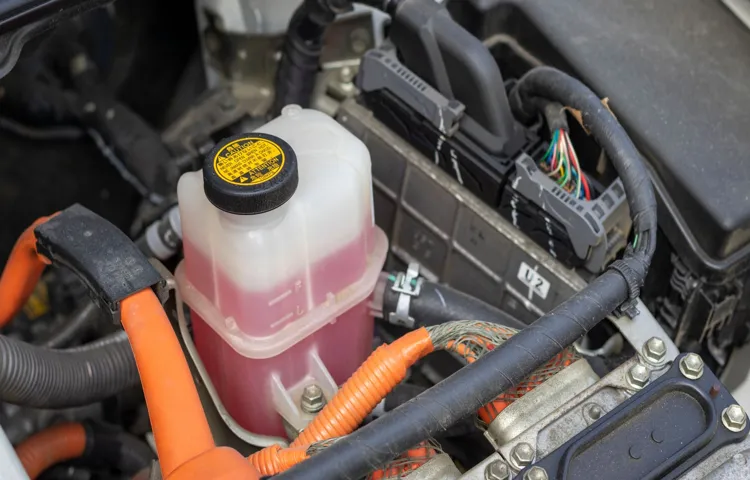Do you ever wonder how your car keeps its cool under the hood? Well, one essential component that helps in this process is the coolant reservoir. Just like how a thermos keeps your coffee hot or cold for hours, the coolant reservoir in your car helps regulate the temperature of the engine. But what exactly is a coolant reservoir, and how does it work its magic? Let’s dive in and find out! Think of the coolant reservoir as a storage tank for the coolant, also known as antifreeze, that keeps the engine from overheating.
It’s like a trusty sidekick, always ready to provide the cooling support your engine needs. This reservoir is usually made of durable plastic and is located near the radiator in the engine compartment. So, how does it work? When the engine is running, it generates a significant amount of heat.
This heat can eventually cause the engine to overheat if not properly regulated. That’s where the coolant reservoir comes into play. It acts as a storage tank for excess coolant, allowing it to expand and contract as needed.
As the engine heats up, the coolant absorbs the excess heat and circulates through the engine block, radiator, and other cooling system components. When the heat is transferred to the coolant, it flows back into the coolant reservoir through a hose. This process continues as long as the engine is running, ensuring that the temperature remains within the optimal range.
The coolant reservoir also acts as a visual indicator for coolant levels. Many coolant reservoirs have markings that indicate the minimum and maximum levels. By simply taking a glance, you can easily check if the coolant level is within the recommended range.
If it’s too low, you can add more coolant to prevent the engine from overheating. It’s important to regularly check the coolant reservoir and ensure that it is properly filled. Ignoring low coolant levels can lead to engine damage, as the engine won’t be effectively cooled.
Table of Contents
Definition and Function
What is a coolant reservoir? Well, think of it as a storage tank for coolant, also known as antifreeze. Coolant plays a vital role in your engine’s health by regulating its temperature and preventing it from overheating. The coolant reservoir serves as a reservoir for the excess coolant that expands when the engine is hot and contracts when it cools down.
This helps maintain a constant coolant level in the system, ensuring that your engine stays cool and operates efficiently. So, the next time you pop the hood of your car and see that little white plastic tank, you’ll know that it’s the coolant reservoir doing its important job of keeping your engine’s temperature in check.
What is a coolant reservoir?
coolant reservoir, function of coolant reservoir, definition of coolant reservoir, importance of coolant reservoir, why coolant reservoir is necessary
Why is a coolant reservoir important?
coolant reservoir, importance, function, definition
Components and Design
A coolant reservoir, also known as an overflow tank or coolant expansion tank, is an essential component in a vehicle’s cooling system. It is typically made of plastic and is connected to the radiator through a hose. The coolant reservoir serves as a storage space for excess coolant that is not needed by the engine.
When the engine gets hot, the coolant expands, and the excess is diverted into the reservoir. As the engine cools down, the coolant contracts, and it is drawn back into the radiator from the reservoir. This process helps to maintain a consistent level of coolant in the cooling system and prevents air pockets from forming, which can lead to overheating.
The coolant reservoir also has a cap that allows for the release of pressure when necessary, ensuring the safety of the cooling system. Overall, the coolant reservoir plays a crucial role in keeping the engine cool and preventing it from overheating.
What are the components of a coolant reservoir?
coolant reservoir, components, design
How is a coolant reservoir designed?
coolant reservoir, components, design A coolant reservoir is an essential part of a vehicle’s cooling system, as it helps regulate the temperature of the engine and prevents overheating. It is typically made of durable plastic or metal and is designed to hold a certain amount of coolant fluid. The reservoir is connected to the radiator through a series of hoses and has a cap that allows for the addition or removal of coolant.
Inside the reservoir, you will find several important components, including a float or sensor that measures the coolant level, a pressure relief valve that releases excess pressure, and a hose that allows for the circulation of coolant. The design of a coolant reservoir is carefully engineered to ensure efficiency and reliability. It must be sturdy enough to withstand the high temperatures and pressures generated by the engine, while also allowing for proper circulation and ventilation of the coolant.
The placement of the reservoir is also important, as it needs to be easily accessible for checking and adding coolant. Overall, the design of a coolant reservoir is crucial in maintaining the optimal performance and longevity of a vehicle’s cooling system.
Purpose and Benefits
A coolant reservoir, also known as an overflow tank or expansion tank, is an essential part of a vehicle’s cooling system. It serves the purpose of storing excess coolant fluid and helps maintain optimal engine temperature. But what exactly does this mean for your car? Well, think of the coolant reservoir as a backup system for your engine.
It’s like having a spare tire in case of a flat – it’s there to save the day when things get a little too hot under the hood. By storing extra coolant fluid, the reservoir ensures that there is always a steady supply of coolant available to keep the engine cool and prevent overheating. So, why is this important? Well, an overheated engine can lead to serious damage and costly repairs.
By having a coolant reservoir, you can avoid these issues and keep your engine running smoothly. Plus, it’s a relatively inexpensive part to replace if needed, making it a smart investment for any car owner.
What is the purpose of a coolant reservoir?
coolant reservoir, purpose of a coolant reservoir, benefits of a coolant reservoir, importance of a coolant reservoir, function of a coolant reservoir The purpose of a coolant reservoir, also known as a coolant expansion tank or overflow tank, is to help regulate the temperature of the engine by storing and providing additional coolant when needed. During the normal operation of a vehicle’s engine, coolant is circulated to help regulate the engine temperature and prevent overheating. However, as the engine heats up, the coolant expands, and without a proper place for it to go, it could potentially cause damage to the engine or even lead to a coolant leak.
This is where the coolant reservoir comes in handy. The coolant reservoir acts as a storage space for the excess coolant, allowing it to expand and contract as needed without putting stress on the cooling system. This helps maintain a constant and optimal level of coolant in the system, ensuring that the engine stays cool and operates efficiently.
Additionally, the coolant reservoir also serves as a visual indicator of the coolant level, allowing drivers to easily check if they need to add more coolant. Overall, the coolant reservoir plays a crucial role in protecting the engine from overheating and prolonging its lifespan.
What are the benefits of having a coolant reservoir?
coolant reservoir, benefits, purpose, efficient cooling system, overheating, temperature regulation, automotive engine, prevent damage, tube rupture, coolant shortage, coolant level, expansion and contraction, coolant recovery tank, overflow tank, radiator pressure cap, coolant circulation, heat dissipation, maintain optimal temperature, engine’s lifespan, prevent premature wear, radiator, cooling fins, hoses, water pump, thermostat, antifreeze, corrosion inhibitor, prevent rust, lubricate water pump, prevent freezing, boiling point, coolant system, hydrolock, prevent engine damage, extend engine’s life, cost-effective, simple maintenance.
Conclusion
In conclusion, a coolant reservoir is like a fancy water bottle for your car. It’s where your vehicle keeps its cool, literally! Just as you would carry around a water bottle to stay hydrated and maintain your body temperature, a coolant reservoir does the same for your engine. It holds the coolant, or antifreeze, that helps regulate the temperature inside your car’s motor.
So, next time you see that funky-looking tank under the hood, remember it’s not just there for style points – it’s a crucial part of your car’s cooling system, keeping things cool when the engine starts to get hot. So if you want your car to be the coolest ride on the block, don’t forget to give some love and attention to your coolant reservoir!”
FAQs
What is a coolant reservoir?
A coolant reservoir, also known as an overflow tank or expansion tank, is a small plastic container that stores coolant (or antifreeze) for the radiator system in a vehicle.
Why is a coolant reservoir important?
The coolant keeps the engine cool by absorbing heat and preventing overheating. The reservoir allows for expansion and contraction of the coolant, ensuring that the radiator system remains at the optimal level.
How does a coolant reservoir work?
The coolant reservoir is connected to the radiator system through a hose. As the engine heats up, the coolant expands and flows into the reservoir. When the engine cools down, the coolant is pulled back into the radiator, maintaining the correct level.
What happens if the coolant reservoir is empty?
If the coolant reservoir is empty, it can lead to overheating of the engine. It is important to regularly check the coolant level and fill the reservoir if it is low.
Can a coolant reservoir leak?
Yes, a coolant reservoir can develop leaks over time. This can be due to cracks in the plastic container or damage to the hose connections. It is important to inspect the reservoir for any signs of leakage and replace it if necessary.
How often should the coolant reservoir be replaced?
The lifespan of a coolant reservoir can vary depending on the quality of the materials used and usage conditions. It is recommended to replace the reservoir every 4-5 years or if there are any signs of damage or leaks.
Can I drive my vehicle without a coolant reservoir?
While it is possible to drive without a coolant reservoir, it is not recommended. The reservoir helps regulate the coolant level and prevents overheating. Without it, you would need to regularly monitor and maintain the coolant levels directly in the radiator.



